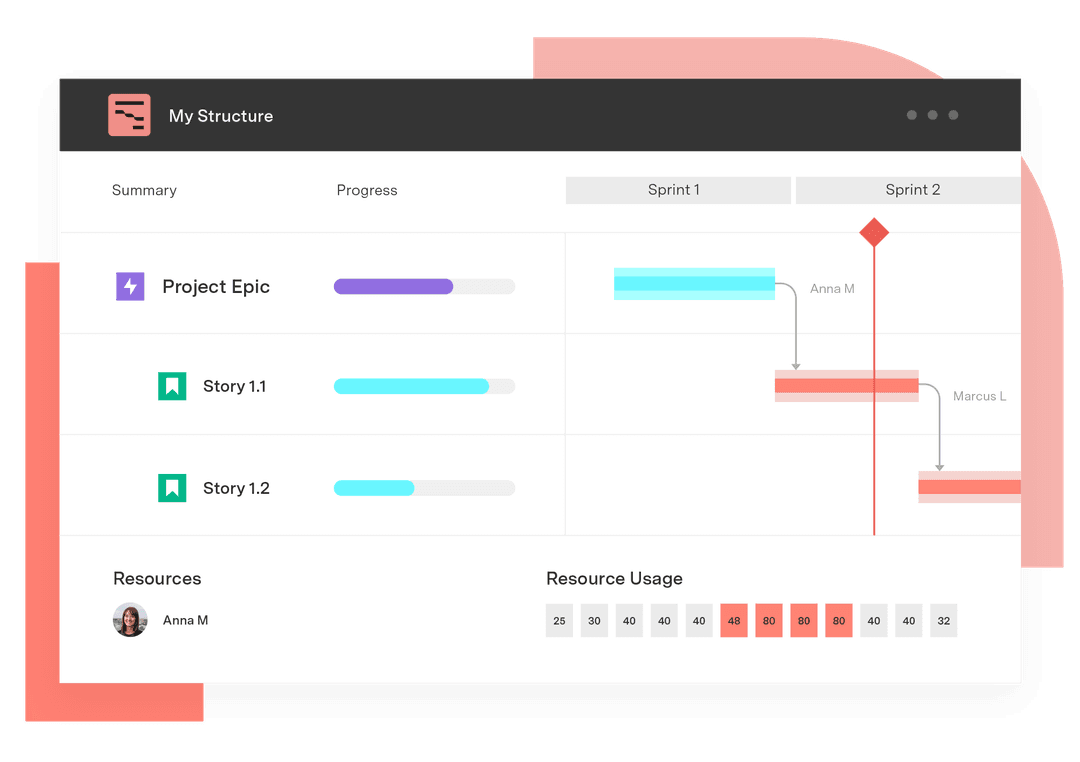A tech toolkit designed for ITSM excellence
Tempo Team
IT service management (ITSM) is how IT teams manage the end-to-end delivery of services to users and customers. ITSM comprises a collection of approaches, processes, and activities to design, create, deliver, and support these services. ITSM tools facilitate the management, delivery, and support of IT services, streamlining processes, and enhancing user experience and efficiency.
These tools (and the people working within them) are tasked with constantly providing more efficiency, lowering costs, improving customer support, boosting employee satisfaction, and probably also preparing lunch for everyone daily.
The demand for more effective tools is clear. According to the AXELOS ITSM benchmarking report 2022, 24% of all organizations wish to replace their ITSM tools (and 11% of organizations, somehow, don’t even have an ITSM tool).
So, with a pressing need for excellent tools to support ITSM, but substandard options out there, how do you scale a support desk? Or get clarity over your entire portfolio while managing the expectations of both your customers and your fellow employees?
Controlling your portfolio
It can take a lot of time to get a full picture of the work, queues, and tickets happening throughout your entire organization, let alone then trying to coordinate it all across teams and projects.
Even with tools at your disposal, having the confidence to make decisions across multiple different pieces of software or aligning different teams and departments across Jira to your wider company objectives is a major task.
Common pain points
Lack of Alignment & focus: when the wrong people are working on the wrong things at the wrong time across teams, services, and projects
Lack transparency
across your portfolio of projects and services to understand risk, dependencies, capacity, and important business metrics like SLA, CSAT, cost, budgets, and forecasting.
Inefficiency:
when you don't have the right data and/or the flexibility to improve processes and reduce costs while improving quality
In fact, according to the Future of ITSM survey, 84% of respondents think that working in IT will get harder over the next three years and 72% of ITSM workers feel “undervalued” to some extent.
How to overcome these issues
If you’ve got a mixture of home-brewed and dedicated solutions, the simplest step towards controlling your portfolio is to use a single source of truth or find tools that are designed to communicate with each other.
The reason for this is that when different teams have to jump from window to window, shift applications for work and reporting, or even have different parts of their work in different tools, it’s more likely that something will slip through the cracks.
With a single source of truth, you can manage your queue sprawl by being able to view multiple service management projects in one place. Teams can see all their work and its status in a centralized location, and you can group and prioritize tickets correctly and then report on workloads without a bunch of mind-numbing double data-entry.
However, the solution often isn’t as simple as just buying the first suite of tools you can find. There are concerns about enterprise software packages, commonly described as monolithic, and the “bloat” they can come with. They're feature-packed, but expensive and filled with clutter that your team has little use for.
This is where Atlassian's Jira Service Management and the Jira family of products really help unlock high velocity service management. What you can't get out of the box, the Atlassian Marketplace offers over 1,000 trusted applications and integrations to ensure Jira Service Management can be customized to fit your use case.
With over 20 years in the Atlassian Marketplace Tempo is ideal for ITSM teams to get the most out of Jira Tempo offers a modular, flexible suite of Jira-native products, meaning that they can all do their intended job as individual tools but have as much integration functionality as possible.
That means your organization gets powerful and flexible new tools that don’t sit outside of your existing workflows or need to be purchased with superfluous software.
Optimizing service excellence
ITSM tools are not just about handling tickets as quickly as possible, although that’s obviously important. Leadership and project managers need a higher-level view to see where bottlenecks develop and understand the cost and time spent across projects in their portfolio.
As teams grow, the flow of information between managers and agents can become more complicated. When your portfolio is on the smaller side, it’s easier to identify and react when problems arise, but when your operation starts to grow you can’t rely on the same tactics as before.
Common pain points
Spending too much time reacting to meet changing customer expectations
Locating bottlenecks and finding where time is being spent
Understanding the total costs of projects across your IT portfolio
It can take far too much of your time as a manager to work out where all your team's time is going, where your money is going, and if all this is matching up to your SLAs.
Once you get to 20+ agents and over a hundred tickets a day, especially if you are working in a sector like healthcare or finance with complex demands, waiting until overload becomes an issue can risk frustrating your customers and losing your best employees to burnout.
But how do you overcome the pain points above and become proactive in your day-to-day operations?
How to overcome these issues
Being proactive with the challenge of optimizing ITSM service excellence means acquiring real-time insights on where your resources are going. It also means getting reliable forecasting and predictive analysis to show you where things might end up in the future.
It’s a major project to try to understand the full cost of support, but it’s the best way to ensure you can make the right investments — both to keep your customers happy and to stop your teams from being driven mad by burning hours of their time and goodwill on the wrong projects.
To understand the full cost of support, you’ll need something like Timesheets – one of Tempo’s modular ITSM tools.
Timesheets is an AI time-tracking tool that automatically logs tickets completed and the time taken for both agents and non-agents, helps to identify pain points in your ticket management process, and shows you where your time (and money) is being spent portfolio-wide.
You can also look into bigger-picture cost and financial management tools like Cost Tracker that track time logged on specific incidents across all teams so you can get easy reports on labor costs, hardware and software expenses, and any expenditure across your project portfolio
Ultimately, the goal of most operations leaders or project managers should be to have a full idea of their available resources and where those resources will be most impactful. If that is in place, then it becomes so much more possible to deliver quality and keep your employees informed and on your side as you start to grow.
Unlocking insights from your data
Jira is an exceptional tool for project tracking. However, as your organization scales and your practices mature, out of the box, it may not provide all the necessary features to for visualization, comprehensive reporting, resource and capacity planning potentially causing teams to miss out on valuable functionality that can significantly simplify how they come together to deliver great digital and service experiences that provide value to customers and drive outcomes.
Access to more data is undeniably valuable, as it empowers teams to generate insightful reports and seamlessly share them with the relevant stakeholders.
Common pain points
Many tools only offer minimal reporting capabilities, leading to delays in decision-making.
Manual data entry is not only time-consuming but also prone to errors.
As ITSM practices continue to evolve, the amount of data being generated has grown exponentially. From resolved tickets to evolving customer needs and changing workloads, the challenge lies in not just having a vast amount of data at your disposal, but rather in having the right data readily available at your fingertips, delivered in a timely manner.
How to overcome these issues
No-one should have to manually scroll through reports to drop statistics into a spreadsheet or presentation deck with the intent of showing it off to executives or customers.
There is probably no greater way to bore your talented team to death than to require them to start filling out onerous spreadsheets. It’s undoubtedly important to have that information, but it is equally time-consuming and error-prone.
Fortunately, there’s a better way. Tempo has tools, such as Structure and Custom Charts, that can organize your data, automatically generate reports from your worklogs, and get them in a shareable form for internal or external use.
Having an integrated approach to your toolkit, as mentioned above, allows you to aggregate information from multiple sources and create easily customizable reports to share risk, status, and ITSM metrics across your organization or directly with customers.
How Tempo’s tools can help
Alignment | Visibility | Efficiency
When it comes to expanding your ITSM operations, you don't have to completely change everything at once. Tempo offers a range of flexible solutions that you can choose from to improve your setup right away. You can also combine tools to enhance your portfolio.
Tempo's advanced suite of tools, including Structure, Planner, Timesheets + Cost Tracker (or Budgets), and Custom Charts, can help organizations improve their IT Service management practice and make the most of Jira Service Management and other Atlassian tools. While each of these products is powerful on its own, we believe that together they can truly unlock service excellence, improve efficiencies, and bring teams together to achieve business outcomes.
Tempo enables you to maximize the potential of your ITSM solution with a suite of tools that are highly flexible, fully scalable, and easy to adopt.
Connect work across multiple teams, projects, or service queues in one view. With Structure you can create custom issue hierarchies and spreadsheet-like overviews of your data so you can visualize and track criteria across your entire portfolio of project and services and turn it all into reports and dashboards. Expand Structure with the Gantt extension to visualize timelines for projects and larger initiatives alongside your service queues - in the same view You can see dependencies and also see the resource utilizations with in your structure which is helpful if you have team members balancing planned vs unplanned work
Ensure your teams always have the capacity and resources to meet support and project demands with a flexible and scalable planning tool for Jira that works both at the team and individual level.
Enterprise-class AI time-tracking that reveals the tickets your agents and non-agents are spending their time on, where the biggest bottlenecks are, and incident resolution times throughout your entire portfolio.
An add-on for Timesheets for Jira that displays a project or portfolio’s real-time financial metrics so you can make more accurate forecasts for the future and better understand the cost of incidents, financial implications of different types of service requests. (on Data Center? Check out Budgets)
Simple yet powerful charts for Jira and Confluence with fully customizable service management dashboards for Jira Service Management to track ticket priority, SLAs met vs breached, CSAT rating, and other key ITSM metrics so your reports are always boardroom-ready. Check out the top dashboards for ITSM.
Tempo’s ITSM Solutions for Jira helps align teams on what matters most, optimize service excellence, make informed decisions with real-time insights to help teams move faster and smarter together as you mature and scale. Learn more
Sign up for a demo
Register











































